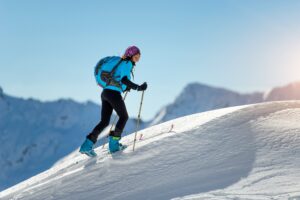Ski Fitness: Preparing Your Body for a Successful Season on the Slopes


As ski season approaches, it’s important to focus on fitness to ensure your body is ready for the physical demands of the slopes. Skiing requires a combination of strength, balance, endurance, and flexibility. You may face fatigue, reduced performance, or injury without proper preparation. In this article, we’ll explore how to build your ski fitness with targeted exercises and techniques to set you up for success during the ski season.
Building Lower Body Strength
Skiing places significant demands on your lower body, particularly the muscles in your legs and glutes. Strong quadriceps, hamstrings, calves, and glutes are essential for maintaining control and stability while navigating varying terrain on the slopes. Incorporating leg-specific exercises into your fitness routine will help you build the power and endurance needed for long days of skiing.
Squats are a key exercise for strengthening the quads and glutes, mimicking the stance and movements involved in skiing. Lunges and step-ups are also highly effective for targeting the lower body and improving balance. Additionally, exercises like calf raises can help strengthen the calves, which are important for stability and edge control.
To ensure all muscles work in harmony, it’s also a good idea to incorporate movements like lateral jumps and side lunges, which improve agility and simulate the side-to-side motions of skiing. Including traditional strength training and dynamic exercises will help prepare your legs for the varied demands of the slopes.
Enhancing Core Stability and Strength
A strong core is essential for maintaining balance and controlling your skiing movements. Your core muscles help stabilize your body as you twist and turn down the mountain, absorb the impact of jumps, and recover from off-balance situations. Neglecting core fitness can lead to poor posture, inefficient movements, and an increased risk of injury.
Planks and side planks are excellent exercises for building core strength, targeting the entire abdominal region and lower back. Russian twists, where you rotate your torso while seated, mimic the rotational movements you’ll perform on the slopes and help improve your ability to initiate turns. Mountain climbers and leg raises are additional exercises that will strengthen your core and improve your stability.
Incorporating balance exercises, such as using a stability ball or balance board, can further enhance your core stability. These tools challenge your balance and coordination, making them ideal for developing the core strength needed for skiing.
Increasing Cardiovascular Endurance
Skiing is not just about strength; endurance plays a major role in your ability to maintain performance throughout the day. Skiers often spend hours on the slopes, and cardiovascular fitness ensures you can keep going without becoming overly tired. Building endurance allows you to tackle challenging runs and recover more quickly between ski sessions.
Cardio exercises like running, cycling, or swimming improve overall endurance. High-intensity interval training (HIIT), which alternates between intense effort and active recovery periods, is particularly effective for ski fitness. This type of training prepares your body for the bursts of energy needed on difficult runs, followed by periods of rest or lighter activity, similar to how you ski down a slope and then rest on the lift back up.
Additionally, exercises that mimic the motions of skiing, such as lateral bounds or using a stair stepper, can help condition your muscles for the specific cardiovascular demands of skiing. Incorporating cardio sessions into your routine two to three times a week will significantly improve your stamina on the slopes.
Flexibility and Mobility for Injury Prevention
Flexibility and mobility are often overlooked aspects of ski fitness, but they are critical in preventing injuries and improving your range of motion. Tight muscles can limit your fluid ability, increasing the risk of strains and sprains. Incorporating stretching and mobility exercises into your routine will enhance your flexibility and reduce the likelihood of injuries on the slopes.
Dynamic stretching before your workout, such as leg swings or arm circles, helps warm your muscles and prepare them for activity. After your workout, static stretches focusing on the hamstrings, quads, calves, and hips are key to maintaining flexibility. Yoga is also an excellent practice for improving flexibility and balance, making it an ideal complement to ski fitness training.
Foam rolling can further aid in recovery and flexibility. This technique helps release muscle tightness, improve blood flow, and promote quicker recovery after intense training or skiing. Including a regular stretching and mobility routine ensures your muscles stay limber, reducing the risk of injury.
Developing Mental Focus and Agility
Skiing is as much a mental sport as it is physical. It requires quick decision-making, concentration, and staying calm under pressure. Mental focus and agility are essential for responding to sudden changes in terrain or weather conditions and navigating difficult slopes.
To improve your mental fitness, consider incorporating exercises that challenge your coordination and reaction time, such as agility drills. Sports like tennis or basketball can also help develop quick decision-making skills, which require fast reactions and adaptability in dynamic environments. Visualization exercises, where you mentally practice skiing-specific runs or techniques, can also enhance your mental preparedness for the slopes.
In addition to physical drills, mindfulness practices like meditation or deep breathing can help you stay focused and calm while skiing. These techniques improve stress management, which can be invaluable when tackling challenging runs or skiing in less-than-ideal conditions.
Skiing is a physically demanding sport that requires strength, endurance, flexibility, and mental focus. By incorporating targeted exercises for the lower body, core, and cardiovascular system and focusing on flexibility and mental agility, you can ensure that your body is prepared for the slopes. As you train for ski season, remember that consistency is key. With the right fitness routine, you’ll be ready to enjoy a successful and injury-free ski season, making the most of every run down the mountain.
